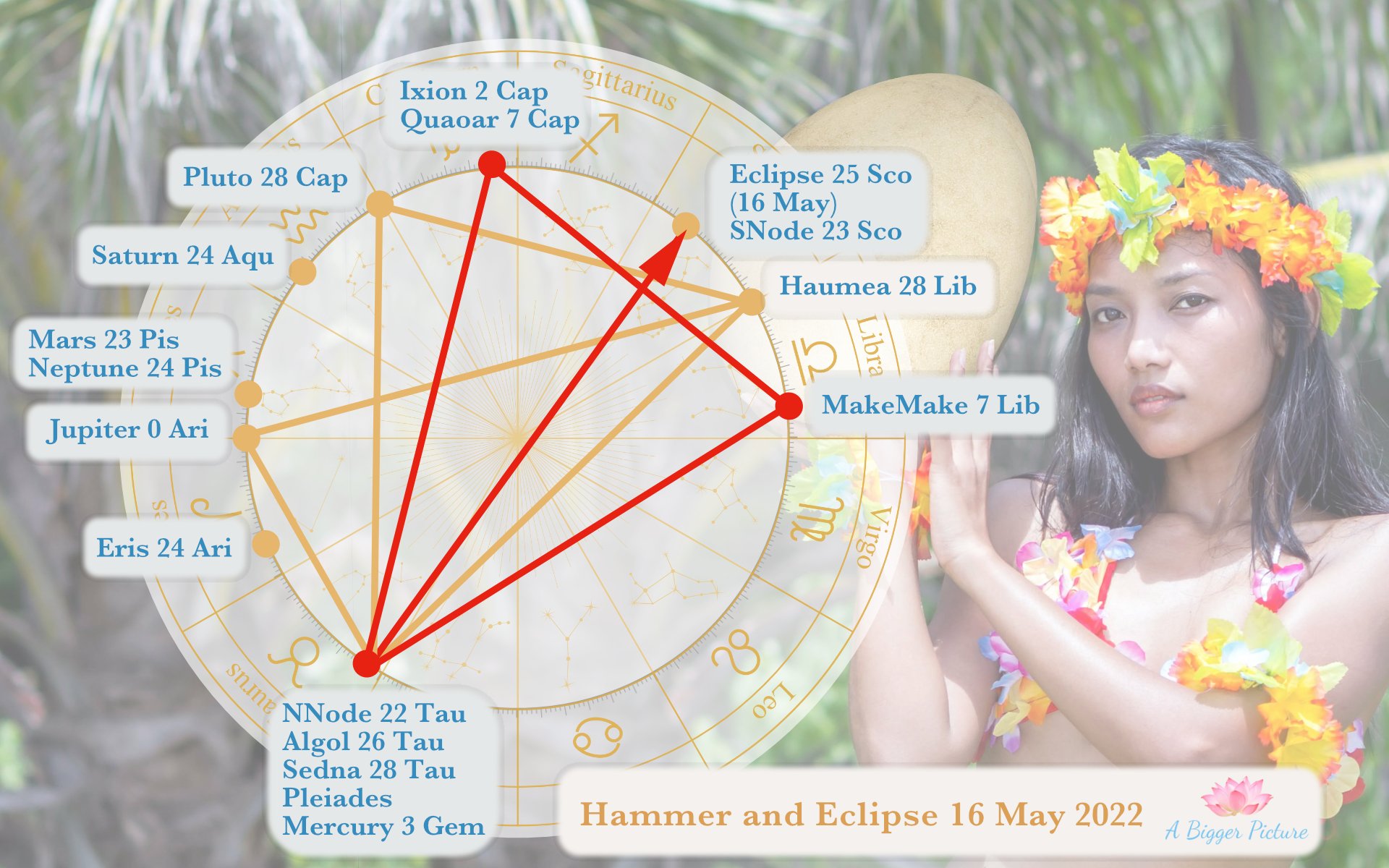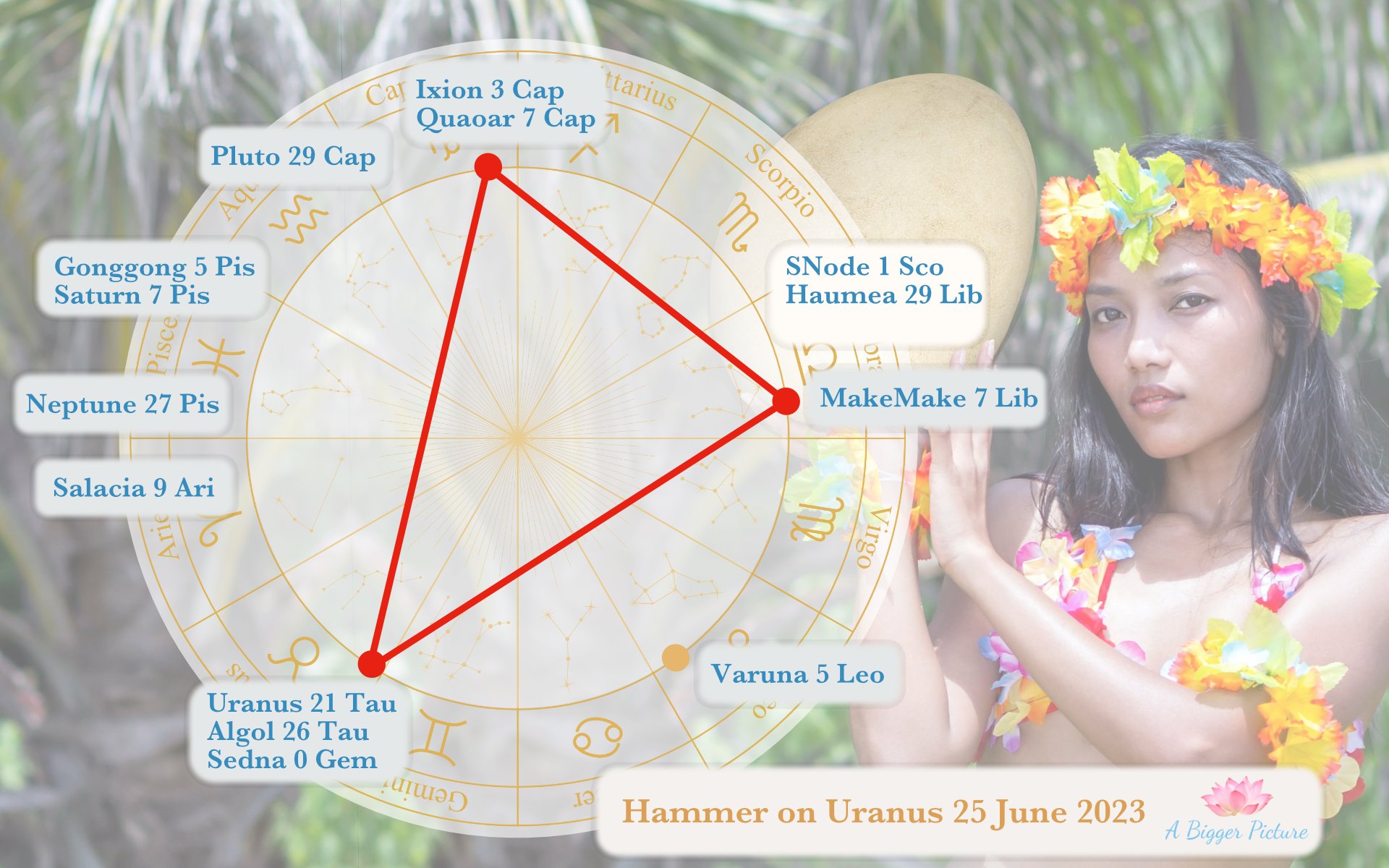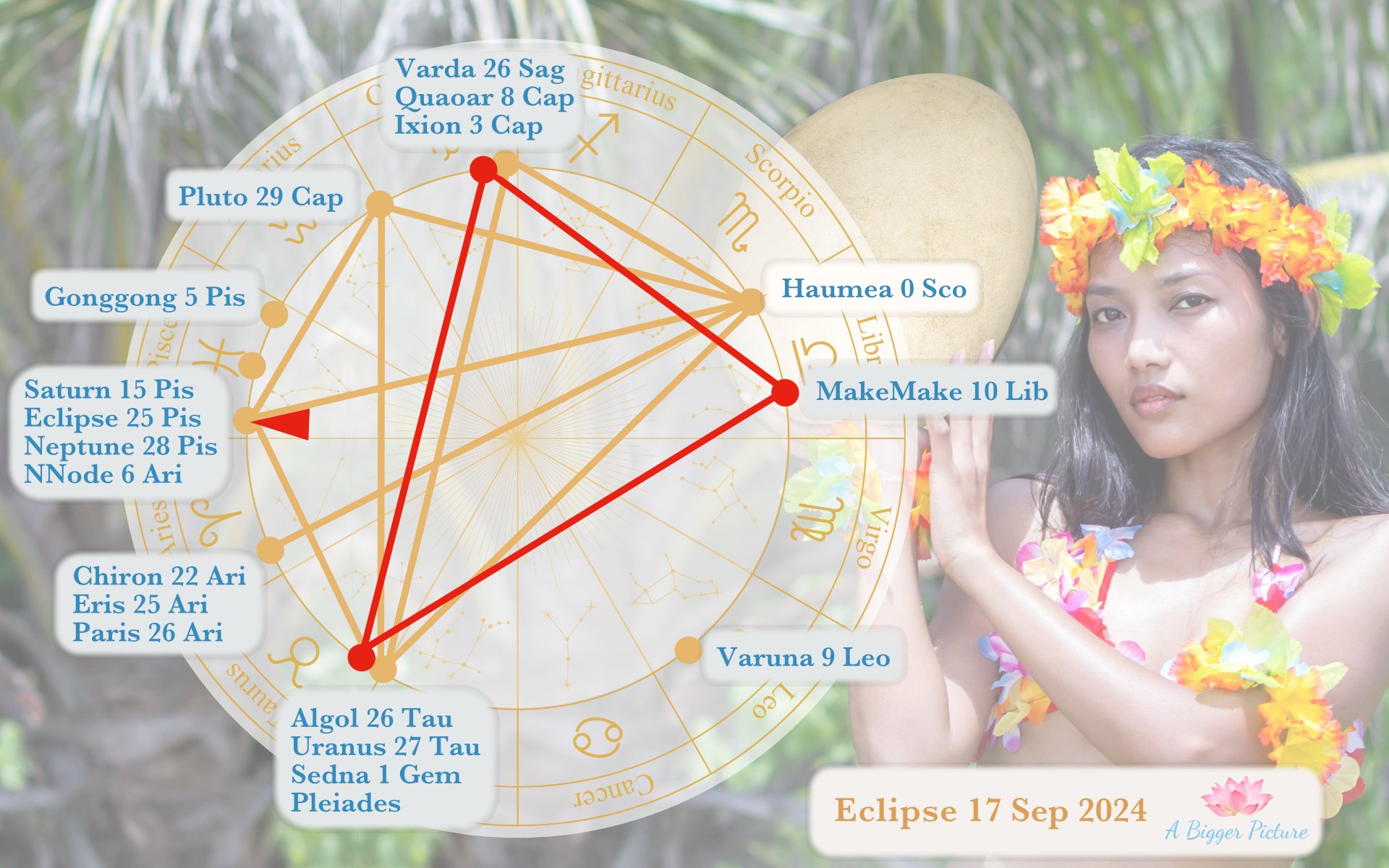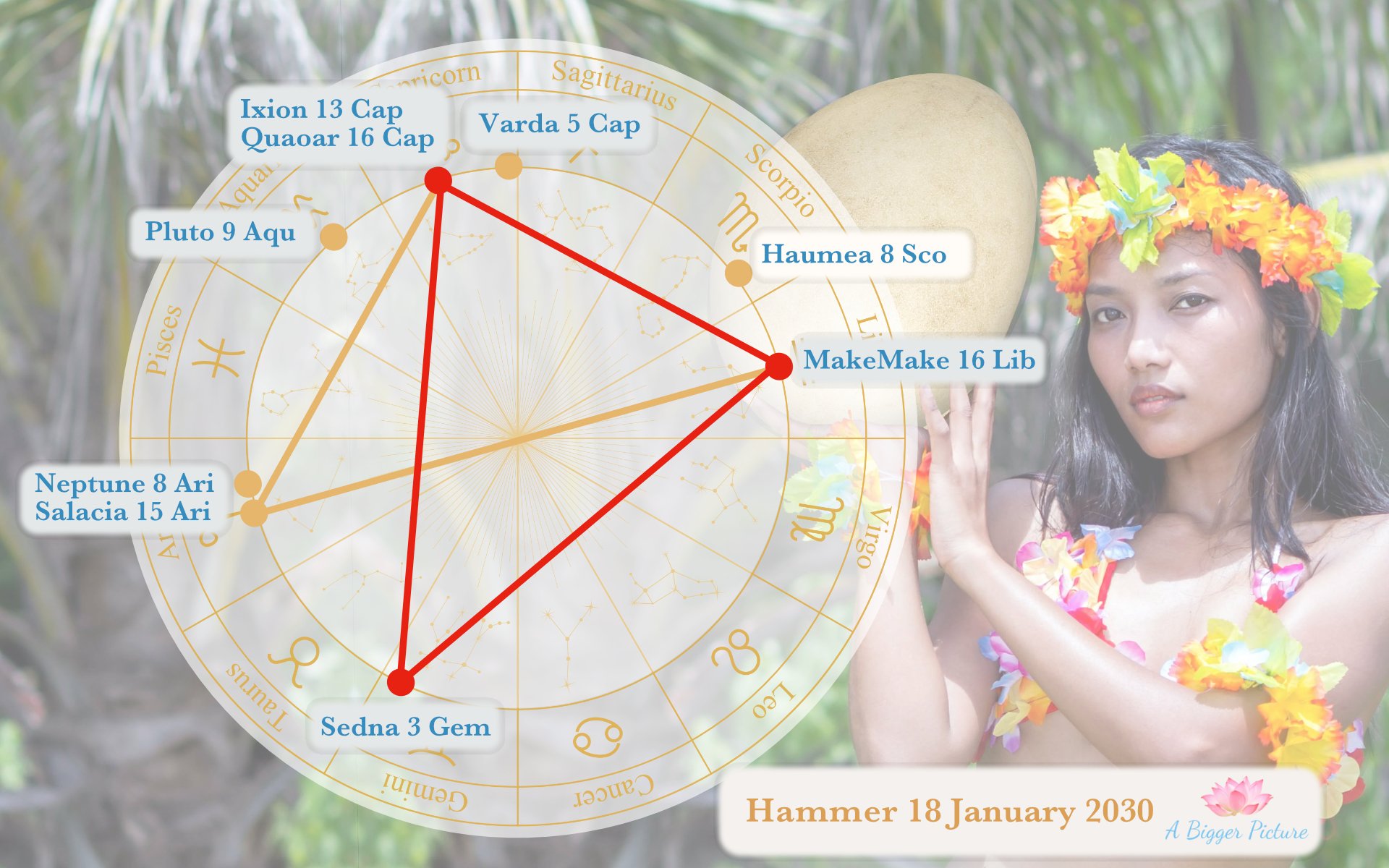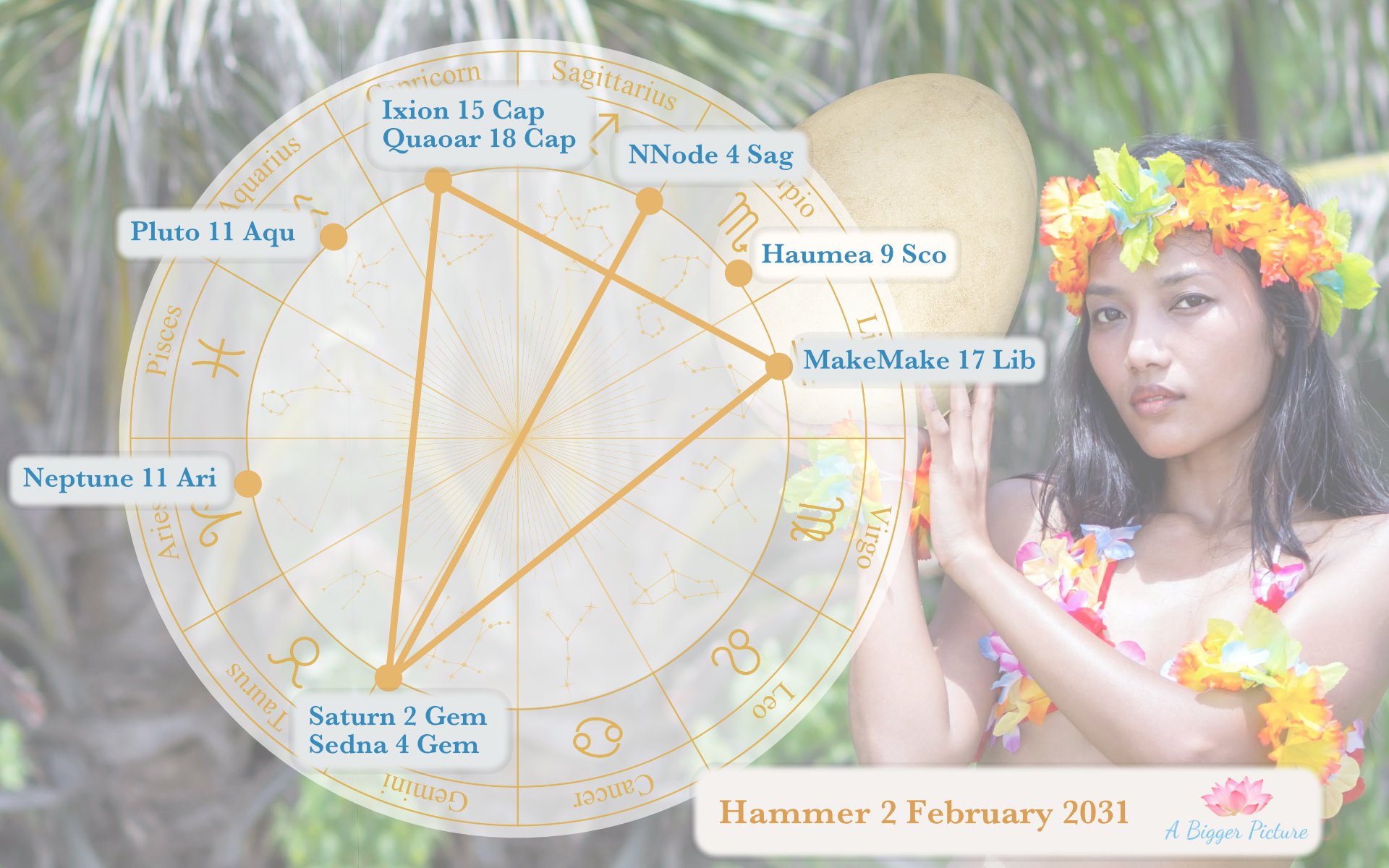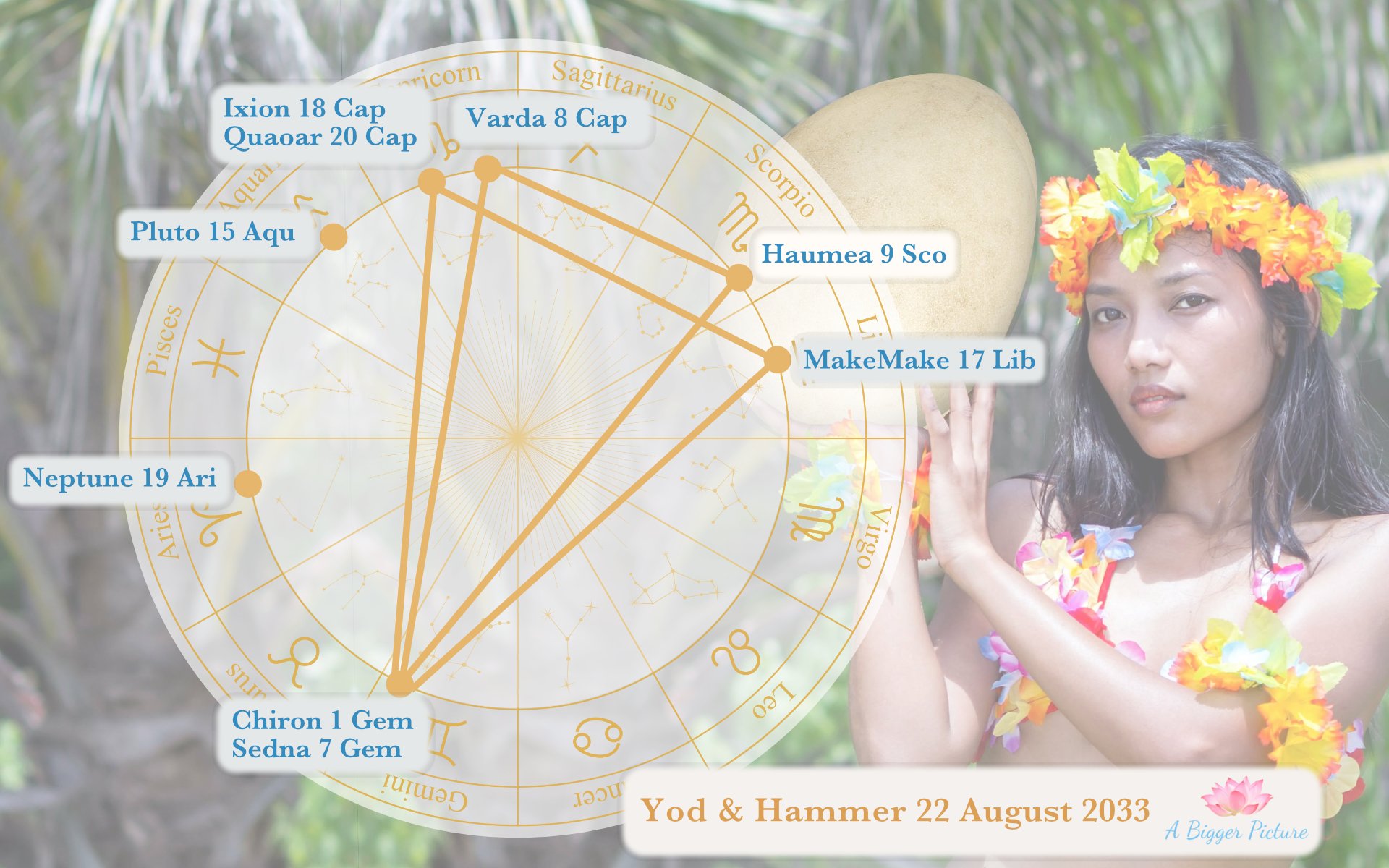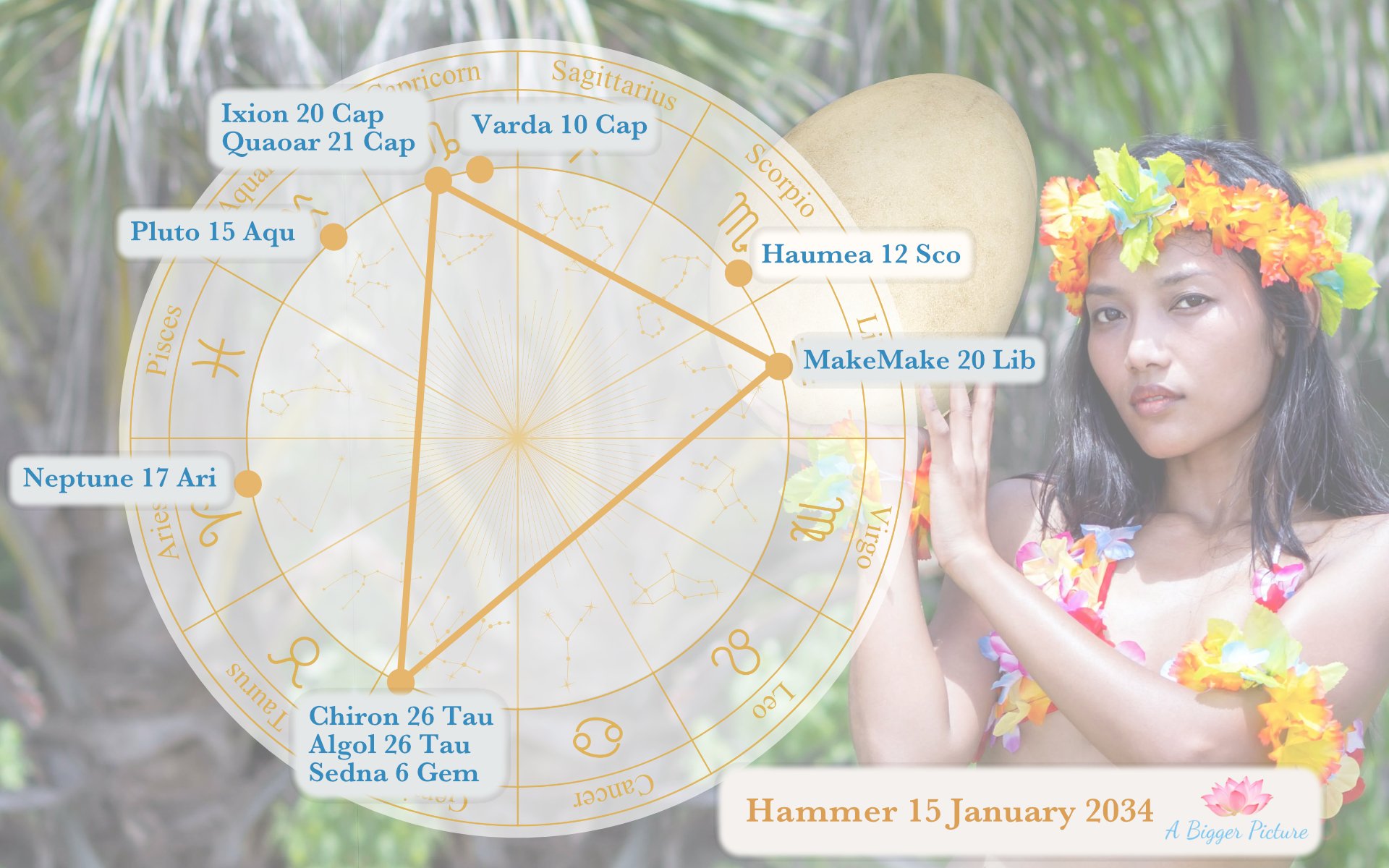Salacia Discovery Chart and Sabian Symbol in Astrology and Astromythology
Trans-Neptunian object in the Kuiper belt Salacia was named after the Roman goddess of saltwater and the wife of Neptune.
Salacia was discovered on 22 September 2004, and takes 273.98 years to orbit the sun.
In ancient Roman mythology, Salacia was the female divinity of the sea, worshipped as the goddess of salt water who presided over the depths of the ocean. Neptune was her consort.
In Greek mythology she is identified with the Greek goddess Amphitrite, consort of Poseidon. Salacia was a sea nymph, who became overwhelmed when distinguished suitor Neptune pursued her for marriage. She managed to glide out of his sight, and hid deep in the ocean. Neptune sent a dolphin to persuade her to return and share the throne with the god of the sea, and was so overjoyed when she agreed, that the dolphin was awarded a place in the heavens, now visible as constellation Delphinus.
According to Wikipedia, Salacia is represented as a beautiful nymph, crowned with seaweed, either enthroned beside Neptune or driving with him in a pearl shell chariot drawn by dolphins, sea-horses (hippocamps) or other fabulous creatures of the deep, and attended by Tritons and Nereids. She is dressed in queenly robes and has nets in her hair. Salacia was the personification of the calm and sunlit aspect of the sea. Derived from Latin sāl, meaning "salt", the name denotes the wide, open sea, and is sometimes literally translated as "the salty one". As his wife, Salacia bore Neptune three children, the most celebrated being Triton, whose body was half man and half fish.
Trans-Neptunian Object Salacia Astrological and Astromythological Significance:
A relevant facet of the Roman myth of Salacia, is that she had been quite successful in hiding from Neptune at the bottom of the oceans where the Sun’s rays of awareness were not unable to illuminate her presence. This, despite the fact that the entire ocean was Neptune’s domain. Why could he not find her in his own domain? Was she the feminine aspect that had been just outside of his awareness, lurking. Neptune is one of the 9 planets in astrology, but Salacia is a trans-Neptunian object, which carries the image of the darkness and awareness of the subconscious WATER ELEMENT is the territory of the goddess aspect of Neptune, as if she was the hidden in the depths of Neptune’s own psyche, from a psychological point of view. In understanding Salacia, it might be useful to see the Neptune Blog, in order to understand her better.
After their wedding, Neptune retained power over the surging ocean, while Salacia received rulership of the sunny, calm surfaces; she was also linked to hot springs with high mineral content by the Romans.
This switchup and coming into the light, is curious, and aligns with the transformation that a maiden undergoes, after she becomes married, and how she blossoms into MATURITY; coming into her own beauty and personal power as a creative being. Consider that the object was initially observed 71 times before its official discovery, with pre-covery dates going back all the way to 1982. Object Salacia was an illusive little thing, and is a true nymph in astromythology.
In myth, it was only a dolphin who was able to find Salacia HIDING in the depths and hidden recesses of the bottom of the ocean (soul domain?), coming to know her secrets.
All the other trans-Neptunian objects carry underworld themes, as it relates to bringing the unawareness, unknown and ‘darkness’ to light, to be seen and lived in the light of day.
Only after her marriage, was Salacia able to become the queen CLEARLY VISIBLE for all to see, often pictured an artwork as sitting on a rock in the ocean in the light of the sun. The image below also shows the remarkable orbital relationship that object Salacia has with Lord of the Underworld Pluto. Salacia orbits the Sun at an average distance that is slightly greater than that of Pluto. Click to enlarge images.
Astrology Glyph for Salacia in Astrology:
To the right is one of the proposed glyphs for Salacia. There is no standard symbol for Salacia used by astrologers either. According to Wikipedia, Denis Moskowitz, a software engineer in Massachusetts who designed the symbols for most of the dwarf planets, proposed a stylised hippocamp as the symbol for Salacia, befitting Salacia as Neptune's consort. This symbol is occasionally mentioned on astrology websites but is not broadly used.
Salacia and Overwhelming Fear in her Discovery Chart:
In the discovery chart, Salacia at 13 degrees Pisces is in wide square to Pluto at 19 degrees Sagittarius and Quaoar at 11 degrees Sagittarius. Salacia is conjuct asteroid Vesta in Pisces, which alludes to her watery home. Underworld psychopomp Mercury in Virgo is in opposition at 17 degrees, with Venus in Leo inconjunct. Neptune is at 12 degrees Aquarius in an aspect called a semi-sextile.
Website Planet Waves.Net considers the following as Salacia’s discovery chart with a time. The chart is casted for 22 September 2004, 11:29:50 AM EST, San Diego, California, with the ascendant at 5 degrees Scorpio. This places Salacia in the 5th astrological house, which is is linked to creativity, ROMANCE, and children. Natal planets in the Fifth House are linked to intrinsic artistic expression and is the house of PLAYFUL recreational activities and joyful pursuits of PLEASURE.
Salacia is conjunct asteroid Vesta in Pisces, and this is perhaps the best indication of what Salacia FEARED MOST initially, as she scrambled to hide from Neptune’s strong advances to marry her. Here it is important to look towards mythology at the definition of a nymph. Different from other Greek goddesses, nymphs are generally regarded as personifications of nature, is typically tied to a specific place or landform, and usually depicted as maidens. The Greek word nýmphē has the primary meaning of "young woman; bride, young wife" but was not usually associated with deities in particular.
Salacia was a sensual maiden sea-nymph that became a goddess upon marriage to Neptune, and in this new role, took on a different artistic and sexual expression.
Salacia surrendered the good life as a playful spirit of the sea waters, to assume the ROLE of a queen of the ocean and water deity, with her beauty shimmering like the sun on water.
Salacia, Feminine Mystique and the Problem that has no Name
There seems to be an element of FEMININE MYSTIQUE to Salacia’s mythological story with its contradictions, as well as what is reflected in the discovery chart, with Salacia being conjunct Vesta, the goddess of hearth and home, in MYSTICAL zodiac sign Pisces. The astrological myth of Vesta entailed beautiful women who were unmarried and had many sacred sexual pleasures ‘in the temple’, and is also the astrological energy of the ‘homemaker’. The phrase "feminine mystique" was coined by Betty Friedan, who wrote a feminist book, to describe the assumptions, that women would be fulfilled from their housework, marriage, sexual lives, and children. The prevailing belief - in 1950s America - was that women who were truly feminine, should not want to work, get an education, or have political opinions.
Betty wanted to prove that women were unsatisfied and could not voice their feelings… and there was fertile ground for this due to an issue pushed into the UNCONSCIOUS, that plagued many women, that spilled over into the lives of unhappy children and men…
Firstly, it is important to note that Betty attended the women's Smith College in 1938 and started to become a political activist, with a strong anti-war stance, occasionally causing controversy. She graduated summa cum laude and Phi Beta Kappa in 1942 with a major in PSYCHOLOGY. She understood ‘the problem’, which were perpetuated by patriarchal society engineers of the time, keeping women in a box convenient for some POWERFUL men to dominate, due to their selfish, overly masculine ideals, expressed as SEXISM. This book exposed the “desperate housewives” of 1950s America, women imprisoned in suburbia with little to do. Betty came to believe that “the only way for a woman, as for a man, to find herself, to know herself as a person, is by creative work of her own.” Betty based women's rights in what she called "the basic human need to grow, man's will to be all that is in him to be". The restrictions of the 1950s, and the trapped, imprisoned feeling of many women forced into these roles, spoke to American women in general, who soon began attending consciousness-raising sessions and lobbying for the reform of oppressive laws and social views that restricted females, and their CREATIVITY. Women are intelligent, they want to produce…
Astrologically, Salacia represents extreme erotic fascination or interest, which is what these powerful men have for women they pursue to marry, but what are their genuine intentions for those women, as it pertains to their wellbeing, or restricting them in ways that contributes to their unhappiness?
The Feminine Mystique was first published on February 19, 1963, with Salacia at 19 degrees Capricorn conjunct Venus, and asteroid Pandora. In her astrology chart, Betty has Salacia at 15 degrees Scorpio, conjunct her Moon, square her Sun at 15 degrees Aquarius. Betty is most famous for her book, but she was criticised for her limited scope because of the narrow focus on white middle-class women who were married with children. Wikipedia explains that chapter one begins with an introduction describing what Betty called "the problem that has no name"—the widespread unhappiness of women in the 1950s and early 1960s. She discusses the lives of several housewives from around the United States who were unhappy despite living in material comfort and being married with children. She also questions the women's magazine, women's education system, and advertisers for creating this widespread image of women. The detrimental effects of ‘the problem’ being kept in the UNCONSCIOUS, induced by this image, were that it cornered women into the domestic sphere, and that it led many women to lose their own IDENTITIES; thus the unhappiness… This is an important point to consider!
Betty Friedan's feminism emphasised the need for freedom to choose career-oriented independence and self-sufficiency, instead of the only option being domestic life.
Pioneer feminist Betty started a sense of emotional liberation, with modern feminism arguably one of the most influential and successful movements of the 20th century, for equal rights and pay.
The Feminine Mystique drew large numbers of white, middle-class women to the feminist cause. Her book "took the complicated and jargon-laden ideas of psychologists, economists, and political theorists, and translated them into powerful, readable, relatable prose that touched millions." Yet, despite A NEW UNDERSTANDING OF WOMEN PSYCHOLOGY, emotional needs identified, feminism and the gender equality movement that Betty progressed, it is only one portion of the energy dynamic…
In the bigger picture, Salacia may be associated with a higher and a lower expression when the FEMININE MYSTIQUE is considered, in the final conclusion of the reader upon having reflected on this article. It may be a long journey to achieve real gender equality in society, however, Salacia found her SATISFACTION in ALLOWING SELF-RENEWAL, and that is the point…
Young, PLAYFUL and beautiful sea-nymph Salacia had reservations about changing her lifestyle, yet after marriage, with its new status and circumstances, she did find fulfilment of a different kind, in multiple ways. Salacia found joy as the sun kissed her face, being out in the open sea and FREE where the sun illuminated everything. Conscious. Fully aware. Unbothered by some boogyman banging in the closet. Object Salacia is a trans-Neptunian object, which entails that journey into the UNDERWORLD, for awareness of those things about herself that she had been in the dark about, inside of herself, coming to light, and growing in MATURITY. All the trans-Neptunian objects carry FEARFUL elements of unawareness, expanding in consciousness and finally the wisdom of an enlightenment (Salacia square Quaoar and Pluto), rooted in having EVOLVED.
In mythology, nymphs or nereids were always ROMANTICIZED beautiful, carefree, young women, who in mythology often ended up married with children to prominent men.
It is not certain what kind of nymph Salacia was before marriage… but the point is that she significantly shifted in new IDENTITY, HIERARCHY and social significance, and got to express herself differently.
According to Wikipedia, in Greek folk religion, the ancient Greek belief in nymphs survived in many parts of the country into the early years of the twentieth century when they were usually known as "nereids". Nymphs often tended to frequent areas distant from humans but could be encountered by lone travelers outside the village, where their music might be heard, and the traveler could spy on their dancing or bathing in a stream or pool, either during the noon heat or in the middle of the night. Such encounters could be dangerous, bringing dumbness, besotted infatuation, madness or stroke to the unfortunate man. When parents believed their child to be nereid-struck, they would pray to a saint.
Object Salacia has one moon called Actaea, who was the nereid of rocky shore or dweller of the coasts or seashore in Greek mythology, see the image to the right.
Salacia Sabian Symbol in the Discovery Chart:
The Sabian symbol for Salacia in her discovery chart is A lady wrapped in a large stole of fox fur. This is the image of a woman of refined taste. Although a fox fur is a symbol of a pricey, proudly worn possession and status symbol, despite its fleeting appeal in fashion, it is none the less an image of a woman who have grown into a certain position that she wears publicly on display, which is what Salacia attained as Neptune’s wife and consort, and all that that entailed being the official ROYAL lady by his side.
Salacia’s overwhelm and desire to run and hide was due to the enormity of the position offered, and the CHANGE in social status and SELF-RENEWAL that it would entail for her.
In mythology Salacia had initially wished to remain unmarried, and preserve her virginity, however in accepting Neptune as her husband after a determined pursuit, she gave up her chastity and innocence. So ‘salacious’ Salacia’s sex appeal seemed to have been, that it aroused the lust of Neptune, that his excessive advances led to her giving up one life, for another. The image of a large fur typically covering the shoulder and bosom of women, is also to protect oneself from unwanted eyes, or intrusive energies while appearing glamorous, or sparkly as the shimmering waters around Salacia had been, when she was seen in daylight. Salacia attained a dynamic freedom of expression upon marriage, which was a dramatic change from her previous life, yet as deeply sensing, feeling and knowing the awareness of the Underworld, this outer ‘persona’ appearance wasn’t able to completely obscure her ‘otherworldly’ wisdom attained, while diving and spending time in the depths of consciousness. Salacia seemed quite the accomplished woman with beautiful assets and social position, having caught the eye of one of the three prominent brothers (Jupiter, Neptune and Pluto), yet not revealing too much of her sacred wisdom and high degree of awareness. Salacia is wrapped in a protective layer that is impenetrable to the passing glance, yet she is also often pictured naked, which is a symbol for - at the core - not carrying falseness nor pretence.
Salacia is AUTHENTICITY, LUXURY and SENSUALITY in the intuition and knowing WATER ELEMENT, yet projective of Self, not allowing exploitation or folly. Salacia is a really good person in the flow of her divine nature.
Object Salacia is said to be as big as Ceres, Quaoar and Orcus in size, but smaller than objects like Eris, Pluto, Haumea, MakeMake and Sedna. Salacia’s dark surface is unusual among trans-Neptunian objects and has the lowest albedo of any known large trans-Neptunian objects. A group of researchers listed a number of ways in which Salacia is exceptional. It's one of the largest trans-Neptunian objects. It's the darkest one in this (intermediate to large) size range. It is also the least dense of the intermediate to large-sized objects whose densities are known (although it should be pointed out that the range of possible densities significantly overlaps the range for Orcus). After that, they allow themselves to speculate a bit.
They suggest that the low density and dark color might mean that Salacia looks more like a primordial trans-Neptunian object, one of the planetesimals from which the solar system's planets were constructed. Stansberry's is one of very few groups of researchers doing the extremely difficult work of following up on the discoveries of distant trans-Neptunian objects by trying to characterize them as more than just moving dots of light. Salacia has one known natural satellite, Actaea. The moon was named Actaea after the Nereid nymph named Actaea.
Experience Salacia Energy:
One of the best ways to experience the energy of Salacia (or any of the other KBOs) is in the week leading up to a Salacia station to go retrograde, or station to go direct. Check your ephemeris or the Calendar of Events.
Transit Salacia in Aries:
Salacia transits seem to be associated with the serene beauty of moonlight on water, emotional calmness and equilibrium, and the peace following overwhelm and salty tears.
This is the aspect of the feminine that swims to the depths to find wisdom there, to bring to the surface and radiate that individualistic and brave AWARENESS and TRUTH. Salacia is is inner strength, playful, in the flow, and is at ease in water (which represents emotions, sensing and feeling in astrology). You may think of Salacia or Amphitrite when you feel unseen things are out of your control, when a good cry is needed due to seeing deep truths as it pertains to the waters, or when standing at the water's edge (emotions and feeling) and needing a little extra strength to get in.
Salacia at 7 degrees Aries, is in the first decan of Aries and part of a long term leg in a T-Square to Quaoar in Capricorn, with MakeMake in Libra that streches beyond 2030, as the slow-moving trans-Neptunian objects move together in an aspect pattern that lasts many years.
Faster moving Neptune will move to conjunct Salacia at 24 degrees Aries, starting in August 2035, with an exact hit on 12 April 2036, and another close conjunction in December 2036.
See the charts below.
Click to enlarge images.



